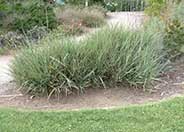
Common name:Coyote Bush
Botanical name:Baccharis pilularis 'Pigeon Point'
'Pigeon Point' is a compact, evergreen groundcover that grows 18"- 24" tall and 10'-12' wide. It is the preferred form of the Coyote Bush. Its leaves are green; it has white flowers that bloom in the fall. It is important to plant this groundcover that are at least 6' -10' apart. Otherwise they will overgrow each other and create a high groundcover. 'Pigeon Point' is tolerant of ocean spray and is deer resistant.

Common name:Canyon Prince Wild Rye
Botanical name:Leymus condensatus 'Canyon Prince'
One of the best known and utilized native grass selections in Southern California, this beautiful, blue gray foliage spreads out 3'-4' or more. It will reach a height of 2'-3'. It rarely flowers. It does spread by rhizomes although not as vigorously as some closely related species. It can be extremely drought tolerant and care must be taken not to over water this species as it can rot from the center. Otherwise, it is carefree and requires virtually no maintenance.

Common name:Carmel Creeper
Botanical name:Ceanothus griseus horizontalis
Carmel Creeper is one of the most popular forms of spreading shrubs. Its glossy oval leaves of 2" are bright green. The tiny, light blue flowers are abundant and form 1" clusters. This shrub benefits from pruning. It does best in well-drained soil with little to no summer water.

Common name:Liquidambar, American Sweet Gum
Botanical name:Liquidambar styraciflua
A tall, deciduous tree of upright, pyramidal habit, the Liquidambar has dark green, maple-like leaves that turn beautiful shades of red and yellow in the fall season. It can be used as a single specimen, hedge, or grouped plant.

Common name:Natal Plum
Botanical name:Carissa macrocarpa
The Natal Plum can be grown as a foliage plant or a flowering plant, and the flowers bloom intermittently with red fruit. The flowers must be pollinated by hand placed where bees can reach them in order to produce fruit.
Sustainable Landscape Renovation
We can identify at least 11 steps of sustainable landscape renovation for consideration. They include critical design, installation and maintenance practices that conform to good principles of appropriate horticulture.
Click in the green box for more information
| Designer: | Low Maintenance Dry Garden |
Photographer: GardenSoft |
Soils and Compost:
Physical weed control, including mulching, or hand removal protects the watershed from harmful chemicals.
Integrated Pest Management:
Drip and other smart irrigation delivers water directly to roots, allowing no excess water for weeds.
